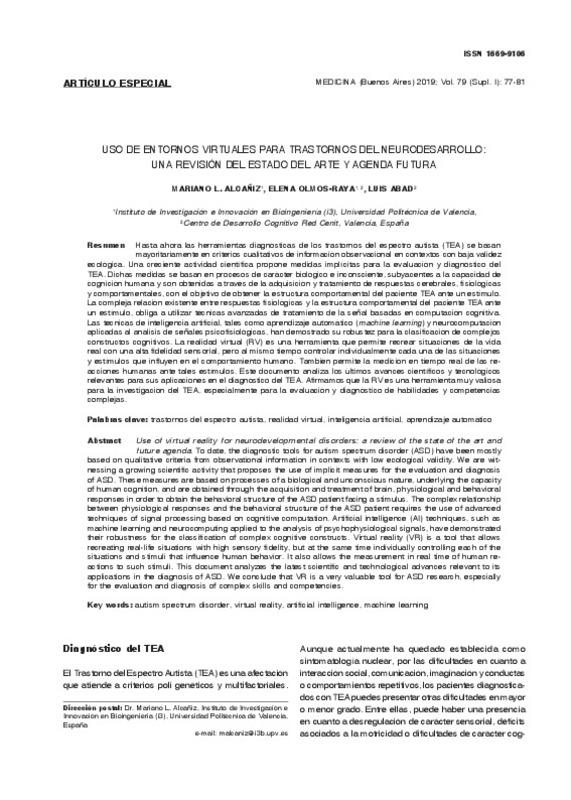JavaScript is disabled for your browser. Some features of this site may not work without it.
Buscar en RiuNet
Listar
Mi cuenta
Estadísticas
Ayuda RiuNet
Admin. UPV
Uso de entornos virtuales para trastornos del neurodesarrollo: una revisión del estado del arte y agenda futura
Mostrar el registro sencillo del ítem
Ficheros en el ítem
| dc.contributor.author | Alcañiz Raya, Mariano Luis
|
es_ES |
| dc.contributor.author | Olmos-Raya, Elena
|
es_ES |
| dc.contributor.author | Abad, Luis
|
es_ES |
| dc.date.accessioned | 2020-12-02T04:31:45Z | |
| dc.date.available | 2020-12-02T04:31:45Z | |
| dc.date.issued | 2019 | es_ES |
| dc.identifier.issn | 0025-7680 | es_ES |
| dc.identifier.uri | http://hdl.handle.net/10251/156263 | |
| dc.description.abstract | [EN] To date, the diagnostic tools for autism spectrum disorder (ASD) have been mostly based on qualitative criteria from observational information in contexts with low ecological validity. We are witnessing a growing scientific activity that proposes the use of implicit measures for the evaluation and diagnosis of ASD. These measures are based on processes of a biological and unconscious nature, underlying the capacity of human cognition, and are obtained through the acquisition and treatment of brain, physiological and behavioral responses in order to obtain the behavioral structure of the ASD patient facing a stimulus. The complex relationship between physiological responses and the behavioral structure of the ASD patient requires the use of advanced techniques of signal processing based on cognitive computation. Artificial intelligence (Al) techniques, such as machine learning and neurocomputing applied to the analysis of psychophysiological signals, have demonstrated their robustness for the classification of complex cognitive constructs. Virtual reality (VR) is a tool that allows recreating real-life situations with high sensory fidelity, but at the same time individually controlling each of the situations and stimuli that influence human behavior. It also allows the measurement in real time of human reactions to such stimuli. This document analyzes the latest scientific and technological advances relevant to its applications in the diagnosis of ASD. We conclude that VR is a very valuable tool for ASD research, especially for the evaluation and diagnosis of complex skills and competencies. | es_ES |
| dc.description.abstract | [ES] Hasta ahora las herramientas diagnósticas de los trastornos del espectro autista (TEA) se basan mayoritariamente en criterios cualitativos de información observacional en contextos con baja validez ecológica. Una creciente actividad científica propone medidas implícitas para la evaluación y diagnóstico del TEA. Dichas medidas se basan en procesos de carácter biológico e inconsciente, subyacentes a la capacidad de cognición humana y son obtenidas a través de la adquisición y tratamiento de respuestas cerebrales, fisiológicas y comportamentales, con el objetivo de obtener la estructura comportamental del paciente TEA ante un estímulo. La compleja relación existente entre respuestas fisiológicas y la estructura comportamental del paciente TEA ante un estímulo, obliga a utilizar técnicas avanzadas de tratamiento de la señal basadas en computación cognitiva. Las técnicas de inteligencia artificial, tales como aprendizaje automático (machine learning) y neurocomputación aplicadas al análisis de señales psicofisiológicas, han demostra do su robustez para la clasificación de complejos constructos cognitivos. La realidad virtual (RV) es una herramienta que permite recrear situaciones de la vida real con una alta fidelidad sensorial, pero al mismo tiempo controlar individualmente cada una de las situaciones y estímulos que influyen en el comportamiento humano. También permite la medición en tiempo real de las reacciones humanas ante tales estímulos. Este documento analiza los últimos avances científicos y tecnológicos relevantes para sus aplicaciones en el diagnóstico del TEA. Afirmamos que la RV es una herramienta muy valiosa para la investigación del TEA, especialmente para la evaluación y diagnóstico de habilidades y competencias complejas. | es_ES |
| dc.description.sponsorship | Este trabajo fue apoyado y financiado por el Ministerio de Economía, Industria y Competitividad de España, bajo el título: Herramientas avanzadas terapéuticas para la salud mental (DPI2016-77396-R) y Entorno virtual inmersivo para la evaluación y capacitación de niños con trastorno del espectro autista: T Room (IDI-20170912). | es_ES |
| dc.language | Español | es_ES |
| dc.publisher | Fundación Revista Medicina | es_ES |
| dc.relation.ispartof | Medicina (Buenos Aires) | es_ES |
| dc.rights | Reconocimiento (by) | es_ES |
| dc.subject | TEA | es_ES |
| dc.subject | Realidad virtual | es_ES |
| dc.subject | Inteligencia artificial | es_ES |
| dc.subject | Aprendizaje automático | es_ES |
| dc.subject | Autism spectrum disorder | es_ES |
| dc.subject | Virtual reality | es_ES |
| dc.subject | Artificial intelligence | es_ES |
| dc.subject | Machine learning | es_ES |
| dc.subject.classification | EXPRESION GRAFICA EN LA INGENIERIA | es_ES |
| dc.title | Uso de entornos virtuales para trastornos del neurodesarrollo: una revisión del estado del arte y agenda futura | es_ES |
| dc.title.alternative | Use of virtual reality for neurodevelopmental disorders: a review of the state of the art and future agenda | es_ES |
| dc.type | Artículo | es_ES |
| dc.relation.projectID | info:eu-repo/grantAgreement/MINECO//IDI-20170912/ES/Virtual Immersive Environment for the Assessment and Training of Autism Spectrum Disorder children (T-ROOM)/ | es_ES |
| dc.relation.projectID | info:eu-repo/grantAgreement/MINECO//DPI2016-77396-R/ES/HERRAMIENTAS TERAPEUTICAS AVANZADAS PARA SALUD MENTAL/ | es_ES |
| dc.rights.accessRights | Abierto | es_ES |
| dc.contributor.affiliation | Universitat Politècnica de València. Departamento de Ingeniería Gráfica - Departament d'Enginyeria Gràfica | es_ES |
| dc.description.bibliographicCitation | Alcañiz Raya, ML.; Olmos-Raya, E.; Abad, L. (2019). Uso de entornos virtuales para trastornos del neurodesarrollo: una revisión del estado del arte y agenda futura. Medicina (Buenos Aires). 79:77-81. http://hdl.handle.net/10251/156263 | es_ES |
| dc.description.accrualMethod | S | es_ES |
| dc.relation.publisherversion | https://www.medicinabuenosaires.com/ | es_ES |
| dc.description.upvformatpinicio | 77 | es_ES |
| dc.description.upvformatpfin | 81 | es_ES |
| dc.type.version | info:eu-repo/semantics/publishedVersion | es_ES |
| dc.description.volume | 79 | es_ES |
| dc.identifier.pmid | 30776285 | es_ES |
| dc.relation.pasarela | S\380114 | es_ES |
| dc.contributor.funder | Ministerio de Economía y Competitividad | es_ES |






